Vi (Snider) Stansfield has shared her memories about life and work while growing up on a farm in Northwestern Ontario during the 1930s and 1940s. She has shared a detailed description about the harvesting of hay, grains and clover.
Hay was cut with a machine called a mower. A mower could be pulled by a horse or by a tractor. A mower had two wheels. There was a blade attached to a shaft that was in turn attached to the wheel of the mower. As the wheel turned, the blade moved side to side cutting the hay. To aid in the process of cutting hay were some prongs that protruded forward, firmly grasping the hay while the blade cut. According to Vi Stansfield, Timothy was the foremost type of hay that was grown and harvested in the Dryden area. After being cut with the mower, the hay would be laying flat on the field.
The second step was to rake the hay into windrows. A horse drawn device that had a metal rake, about ten feet wide, was used to rake the hay. The prongs of the rake touched the ground, and as the wagon moved forward, the rake would gather the hay laying on the field. When there was enough hay the farmer pressed on a foot pedal which caused the rake to lift the load and drop the hay into a pile called a windrow. A windrow is best described as a pile of hay that formed a row on the field.
Vi as a young child sitting on the implement used to rake hay
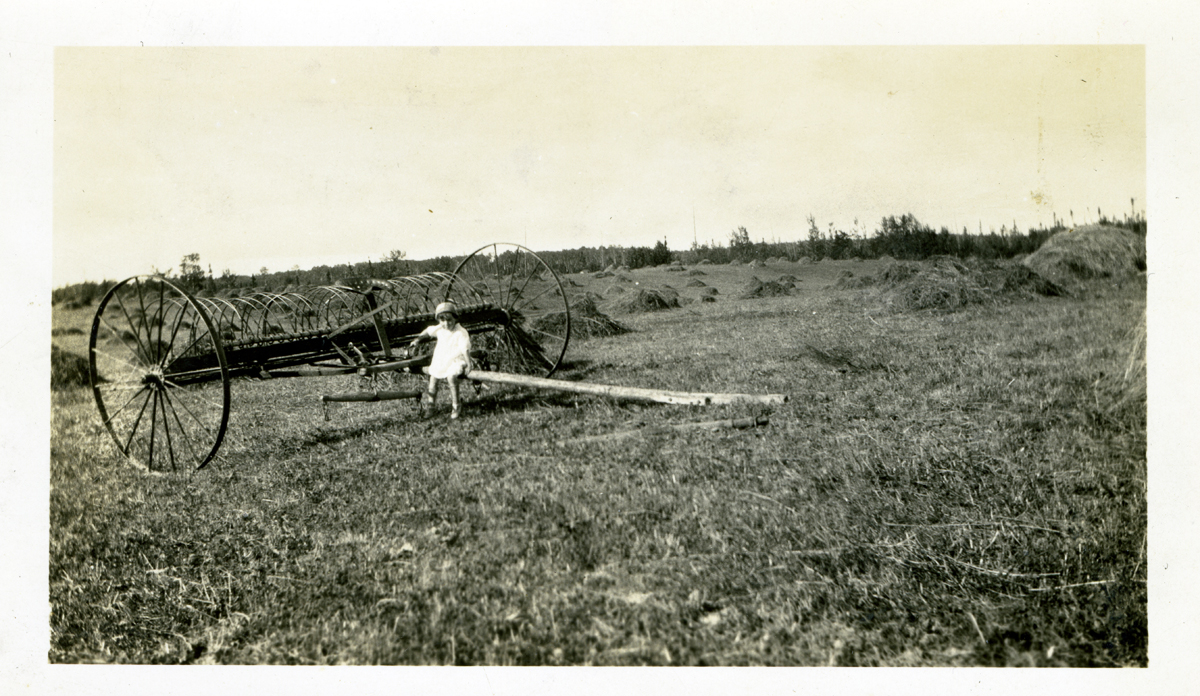
Using a pitchfork that had three tines one would build a hay coil from the windrow. A hay coil was a pile of hay that was about three feet high and three feet in diameter. There was a special technique to building a hay coil, and it took some practice. The idea was to pile the hay up to a peak so that there was a slope on the hay and any rainfall would run off the hay. In that way the hay dried. Any hay that was stored in a barn and not fully dried could heat up and combust and burn the entire barn. After approximately one week, Vi would examine the coil and if the hay was not fully dried, she would reconstruct the coil so that it properly dried.
When the hay was sufficiently dry, it was collected and loaded on to a hay rack. A hay rack was built and placed on a wagon and it could be easily removed from the wagon when not needed. The hay rack had wooden poles built on to the corners to support the hay as it was being transported to the barn. Using pitch forks, Vi's father would load the hay rack with the dried hay. Loading hay and piling it on a wagon was a task that required a fair amount of effort on one's part. At the same time Vi was on top of hay rack building the load.
At the barn there was a hay mow (pronounced maue) which was an opening at the upper level of the barn. The opening to the barn was not too big so that it could be covered during the winter time. Vi's father would park the hay rack at the mow and using a pitch fork would fork the hay through the opening. Vi would be standing inside the second level of the barn on the mow. As the hay was tossed her way, she would, using all her might, push the hay as far back into the barn as possible. The hay in the barn was used to feed the animals and as well it served to insulate the animals from the cold winter winds.
There were a number of steps that were performed in the harvesting of wheat. The first step, cutting the wheat, was done using a binder. The binder had a blade similar to the mower, but when the wheat was cut it did not drop to the ground but rather fell onto a conveyor belt that kept the heads of the grain in the same direction. Once enough wheat fell onto the conveyor, it was automatically bound with binder twine. Binder twine was type of very strong string, possibly made of hemp. The bound wheat was called a sheaf. The last step was to eject the sheaf from the binder on to the field.
Following the binder on foot, Vi would collect the sheaves and build a stook. Again there was a technique to building the stook, it did not simply involve piling the sheaves of grain together. The stook had to be on the field standing up. A stook was about four sheaves in length for a total of about eight sheaves. If the stook was any larger, the grain would not dry properly. The stook was built vertically so that the heads of the grain were pointing in the same direction. Depending on the weather, stooks were left to dry on the field for a period of about one week. When dried, the stooks were loaded on to a hay rack and brought to the barnyard.
Vi's father Jack in the center with Jack Junior on the left and Vi on the right
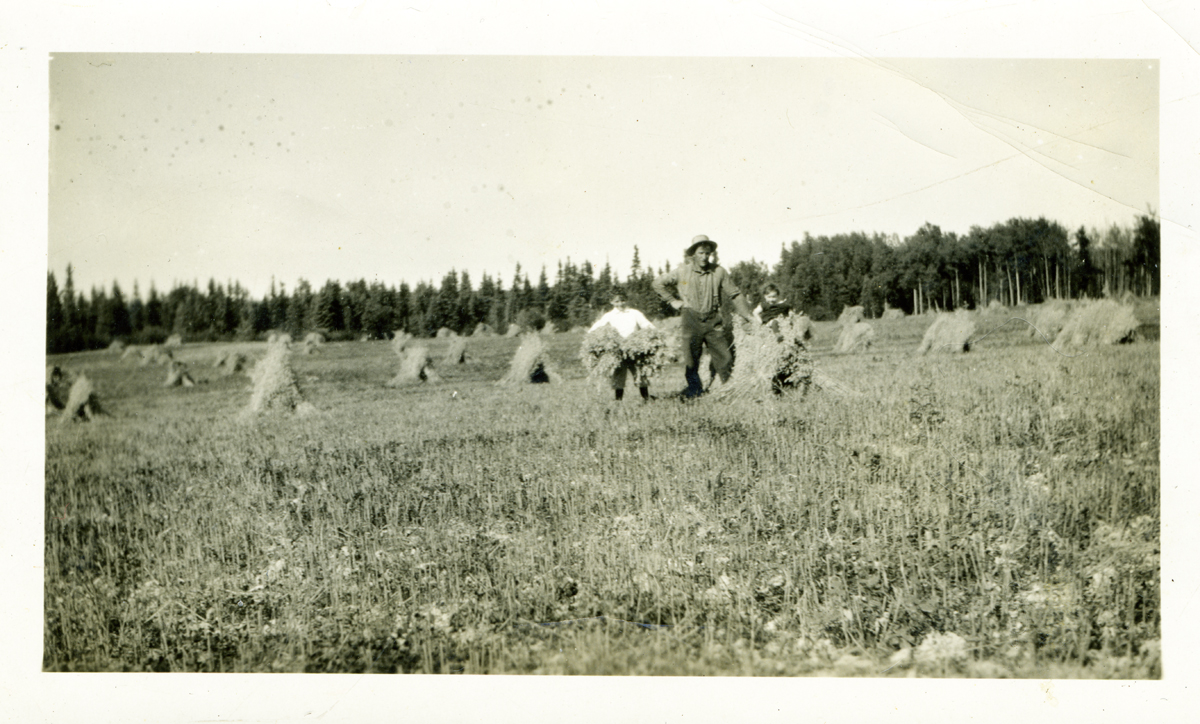
From the hay rack the sheaves of grain were built into stacks. A stack was about fifteen feet in diameter. The butt end of the grain was positioned to be on the outside of the stack with the heads of grain on the inside of the stack. After constructing the lower part of the stack, successive layers of sheaves were added so that the entire structure resembled a dome shaped pile of sheaves. Again it was built in this way to facilitate proper drying of the grain. Vi clearly remembers her father overseeing and directing her in the building of the grain stacks.
Threshing machine on the left. Not sure of the type of grain

The second part involved using a threshing machine to remove the grain from the stack. Since there were only a few threshing machines in the countryside, the machine was usually shared by several farmers. The threshing machine was powered by a steam or gasoline fired tractor. The tractor had long belts attached to the threshing machine. The farmers would take a sheaf from the stack and feed it into the threshing machine. As a child Vi remembers the opening to the threshing machine as a large jaw that raked in the sheaves of grain, and she was fearful of it. She learned quickly to stay away from that opening. Actually, according to Dryden resident Elmer Lick, the opening of the threshing machine had blades that would cut the wire that bound the sheaf together. Then the sheaves would pass through a cylinder that separated the grain from the straw. The grain came out a spout to the farmer who was holding a sack that collected about 75 pounds of grain. The grain was then dumped into a bin in a shed called a granary. There was a bin in the granary for each different type of grain. The straw that was separated from the heads of the grain was blown out a long cylindrical spout (called a blower)into a stack. The stack was used in the winter as bedding for the animals.
It is not known if the tractor here is steam driven or gasoline driven. It might be a Rummley or an International Titan
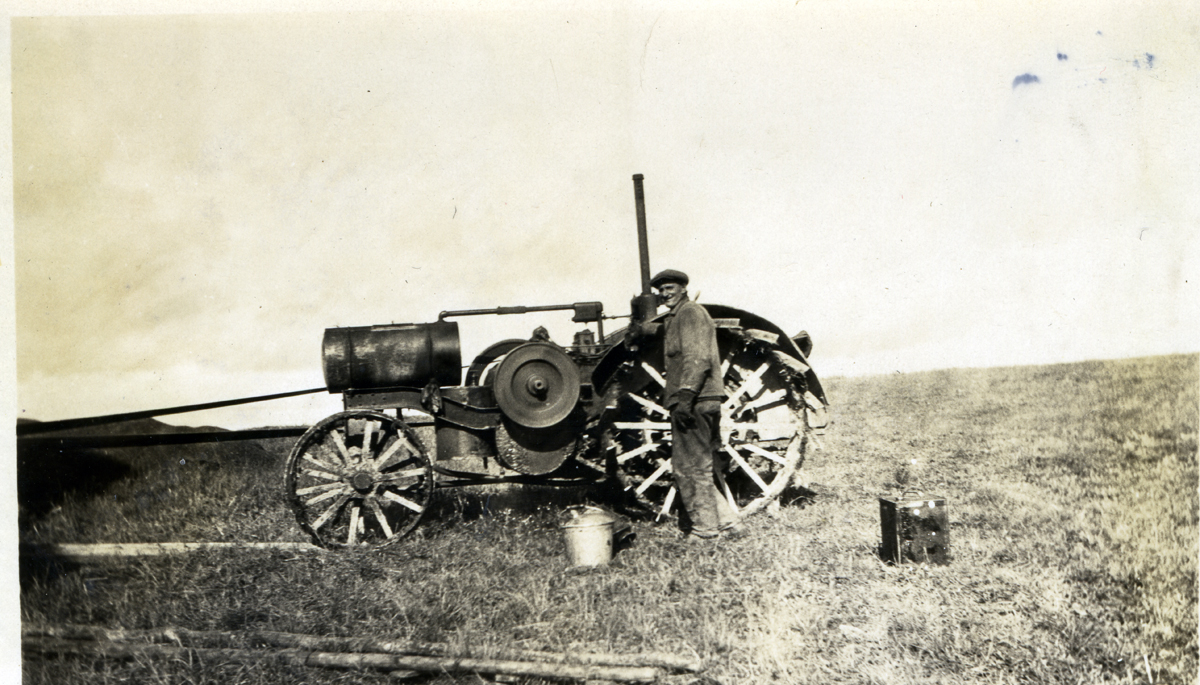
The advent of the Combine simplified the process of the harvesting of wheat. The combine combined the cutting and threshing steps into one step. Therefore, a combine would cut wheat, and separate the grain from the shaft all in one step. According to Elmer Lick, the word combine came from the fact the this machine combined the two tasks to harvesting wheat.
Threshing clover. Examine the length of the belts used to run the threshing machine
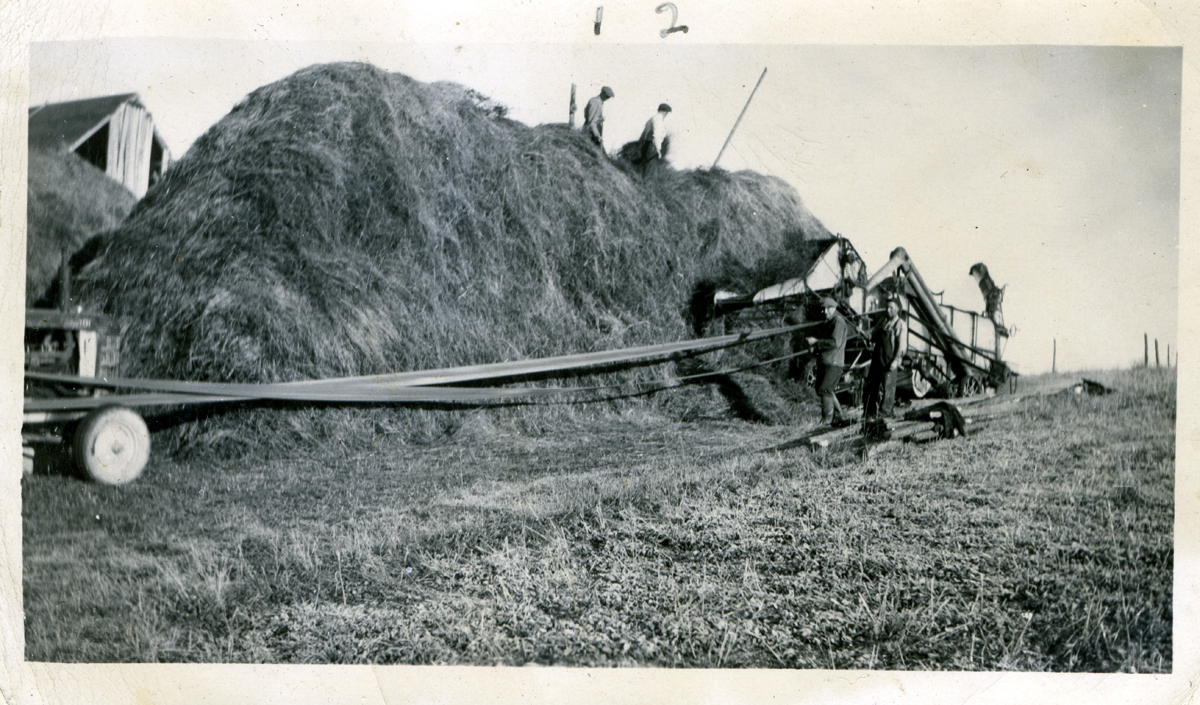
The process of harvesting clover was similar to the method of harvesting hay and harvesting wheat or oats. Clover was cut by a mower, but it was not coiled like hay. It was simply tossed into a windrow. But similarly to wheat, clover had to be threshed by a threshing machine. As a child, Vi would follow behind the mower as it was cutting the clover. Then she would toss the clover clear so that when the mower pulled by horses came back on the next round the horses would not trample the clover. The clover was stored as a windrow on the field and when it had dried it was stored in a large stack near the barn. These stacks were at times twenty feet high. As mentioned, clover had to be threshed by a threshing machine and this was done at the end of the season as threshing machines were shared by farmers in the area.
Two argicultural representatives visting a field of clover in Dryden
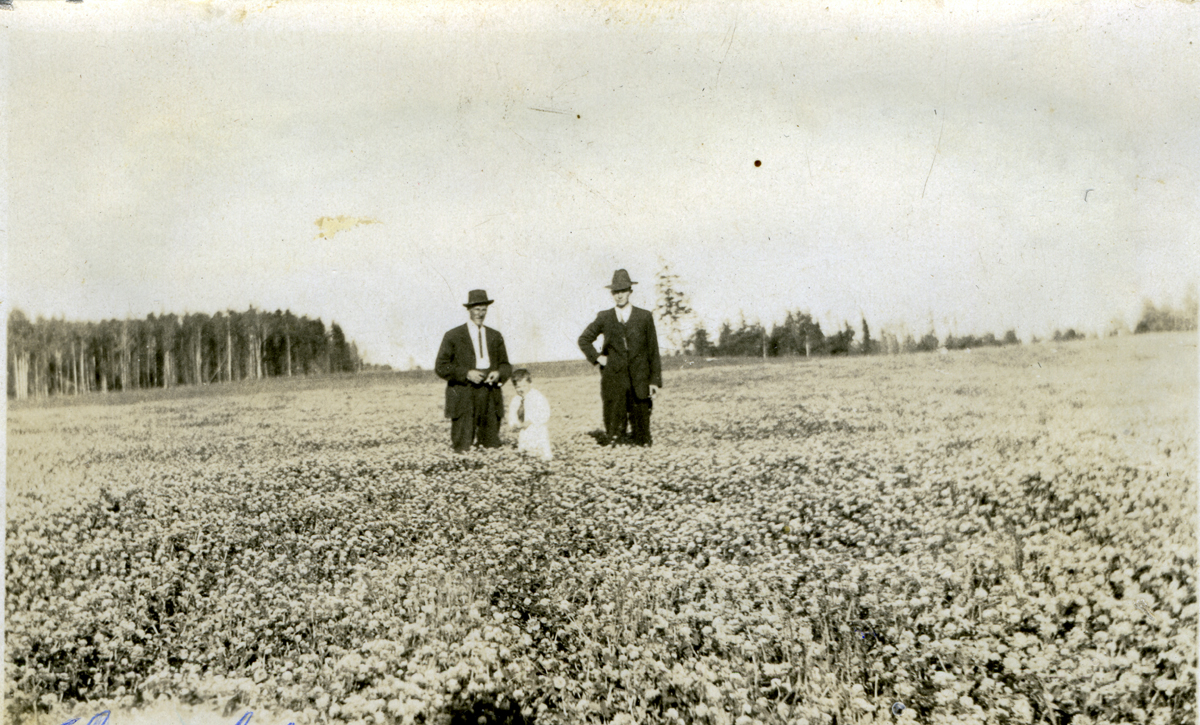
According to Elmer Lick, farmers in the Dryden area usually grew two crops of clover every season. The first crop was threshed and the clover grain was used for hay. The second crop of clover was used as seed for farmers in southern Ontario. The main type of clover grown in this area was alsike. Another type of clover that was grown to a much lesser extent is called red clover.
In the Dryden area, mostly wheat, oats and barley were grown. Oats were mainly for the horses. Barley and wheat would be taken to the local seed growers association building in Oxdrift. Here the equipment was had that would grind or chop the grains into feed for calves, pigs and chickens. Some wheat would also go to a milling company which made it into flour for bakeries or home baking. Clover seed, being the main money crop, was cleaned and sold through the seed growers association.
Pictured here is Elmer Lick's father sitting on a machine that raked the hay on the field and dropped it as a windrow. Notice the pedal on the left where once pushed would drop the appropriate amount of hay into a windrow
